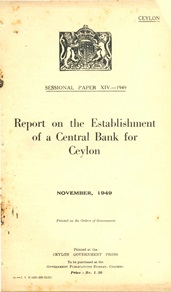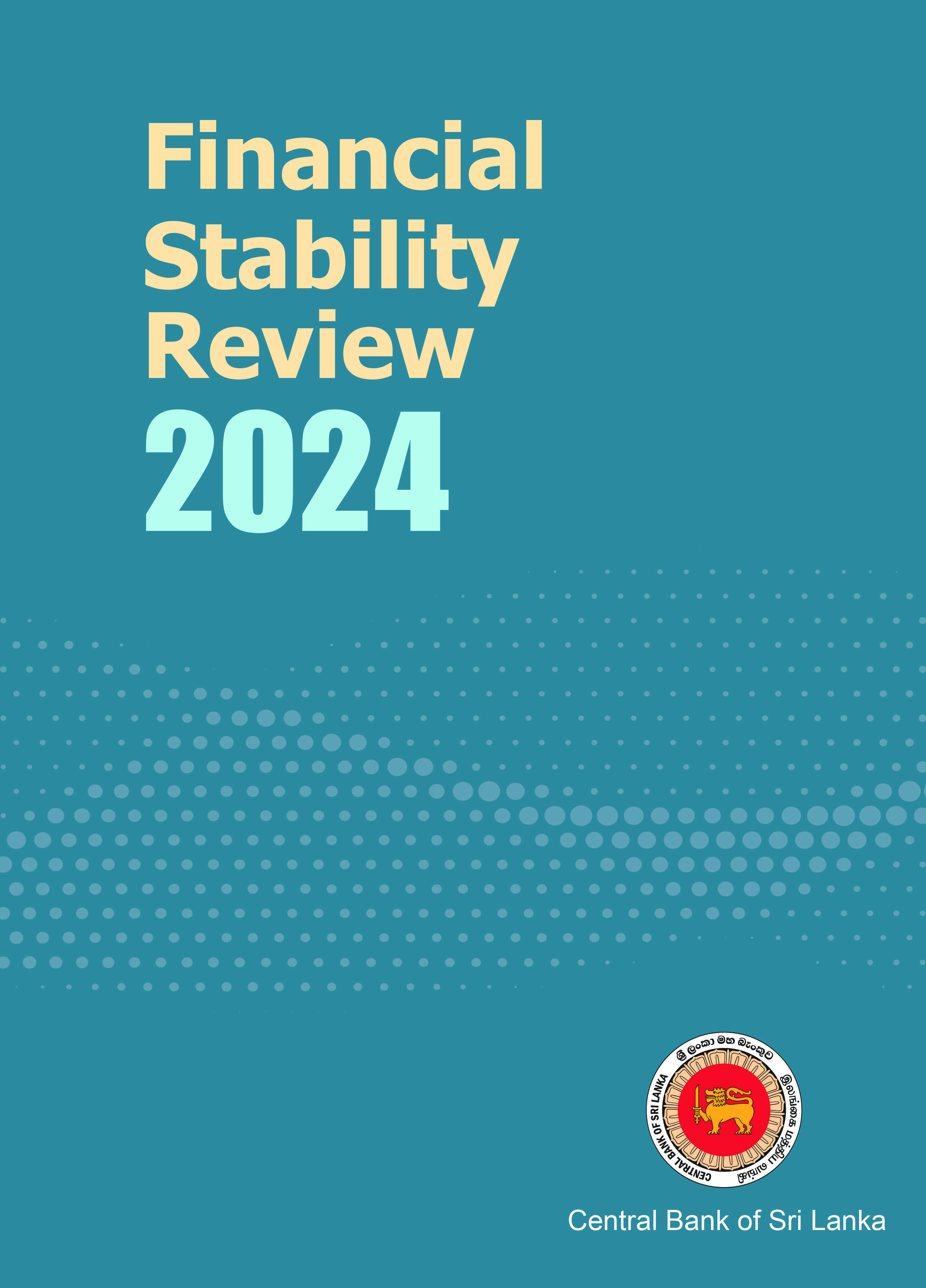அடிக்கடி கேட்கப்படும் கேள்விகள்
தீா்மானம்
தீர்மானம்
1. நிதியியல் நிறுவனமொன்றில் தீர்மானம் எனப்படுவது யாது?
தீர்மானமென்பது நிறுவனமொன்றின் முக்கிய தொழிற்பாடுகளை தொடர்ச்சியாக மேற்கொள்ளுதல், நிதியியல் உறுதிப்பாட்டை பாதுகாத்தல் அத்துடன் வரிசெலுத்துநர்களுக்கு குறைந்தபட்ச செலவினை உறுதிப்படுத்தல்; உட்பட பொதுமக்களை பாதுகாக்கும் நோக்குடன் மத்திய வங்கி மூலம் அதன் தீர்மான அதிகாரங்களை நடைமுறைப்படுத்துவதன் வாயிலாக நிதியியல் நிறுவனமொன்றை மீளக் கட்டமைத்தல் ஆகும்.
2. தீர்மானத்தின் குறிக்கோள்கள் யாவை?
நிதியியல் நிறுவனத்தின் தீர்மானம் பின்வருவனவற்றை உறுதிப்படுத்துமாறு வேண்டப்படுகின்றது:
கொடுப்பனவு, கொடுத்துத் தீர்த்தல் முறைமைகள் உட்பட நிதியியல் முறைமையின் உறுதிப்பாடு;
அத்தகைய நிதியியல் நிறுவனத்தின் தொடர்ச்சியான முக்கிய தொழிற்பாடுகள்;
பொதுமக்களின் நிதியியல் ஆதரவை குறைப்பதன் மூலம் பொதுமக்கள் நிதியங்களை பாதுகாத்தல்;
அத்தகைய நிதியியல் நிறுவனங்களின் வைப்பாளர்களை பாதுகாத்தல்; அத்துடன்
சொத்துக்களின் பெறுமதி அழிப்பை தவிர்த்தல் கடன்கொடுநர்களுக்கான இழப்புக்களை குறைத்தல் மற்றும் அத்தகைய நிதியியல் நிறுவனம் ரீதியான தீர்மானத்தின் ஒட்டுமொத்த செலவினங்களை குறைத்தல்.
3. இலங்கையில் நிதியியல் நிறுவனங்களின் தீர்மானங்கள் தொடர்பில் ஏற்புடைத்தான சட்டவாக்கங்கள் யாவை?
இலங்கையின் நிதியியல் நிறுவனங்களின் தீர்மானங்கள் தொடர்பில் ஏற்புடைத்தான சட்டவாக்கங்கள் பின்வருமாறு:
2023ஆம் ஆண்டின் 16ஆம் இலக்க இலங்கை மத்திய வங்கிச் சட்டம்;
2023ஆம் ஆண்டின் 17ஆம் இலக்க வங்கித்தொழில் (சிறப்பு ஏற்பாடுகள்) சட்டம்; அத்துடன்
2011ஆம் ஆண்டின் 42ஆம் இலக்க நிதித் தொழில் சட்டம்.
4. இலங்கையில் நிதியியல் நிறுவனங்கள் தொடர்பான தீர்மானத்திற்கு பொறுப்பாகவிருப்பவர் யார்? அத்துடன் மேலே குறிப்பிட்ட சட்டவாக்கங்களால் உள்ளக்கப்படும் நிதியியல் நிறுவனங்கள் யாவை?
2023ஆம் ஆண்டின் 16ஆம் இலக்க இலங்கை மத்திய வங்கிச் சட்டத்திற்கமைவாக, இலங்கை மத்திய வங்கியானது நிதியியல் நிறுவனங்கள் தொடர்பான தீர்மானத்திற்கு பொறுப்பாகவுள்ள அதிகாரியாக இருக்கின்ற அதேவேளை வங்கித்தொழில் (சிறப்பு ஏற்பாடுகள்) சட்டமானது உரிமம்பெற்ற வங்கிகளையும் உரிமம்பெற்ற நிதிக் கம்பனிகளையும் தீர்ப்பதற்கு இலங்கை மத்திய வங்கியை வலுப்படுத்துகின்றது.
இலங்கை மத்திய வங்கியின் வைப்புக் காப்புறுதி மற்றும் தீர்மானங்கள் திணைக்களமானது தீர்மானம் பற்றிய அதிகாரசபையுடன் தொடர்புபட்ட இலங்கை மத்திய வங்கியின் தத்துவங்கள், கடமைகள் மற்றும் தொழிற்பாடுகள் ஆகியவற்றை முறையான மற்றும் காத்திரமான விதத்தில் நடைமுறைப்படுத்தல், செயலாற்றுதல் மற்றும் நிறைவேற்றுவதற்காக வங்கித்தொழில் (சிறப்பு ஏற்பாடுகள்) சட்டத்தின் கீழ் தாபிக்கப்பட்டது. இதற்கமைய, உரிமம்பெற்ற வங்கிகள் தொடர்பிலான தீர்மானங்கள் மற்றும் முடிவுறுத்தும் அதிகாரம் இலங்கை மத்திய வங்கியின் வைப்புக் காப்புறுதி மற்றும் தீர்மானங்கள் திணைக்களத்தின் பணிப்பாளரிடம் ஒப்படைக்கப்பட்டுள்ளது. எவ்வாறாயினும், நிதித் தொழில் சட்டத்திற்கான முன்மொழியப்பட்ட திருத்தங்கள் சட்ட மூலமாக்கப்படும் வரை வங்கித்தொழில் அல்லாத நிதியியல் நிறுவனங்களின் மேற்பார்வைத் திணைக்களத்தின் பணிப்பாளர் உரிமம்பெற்ற நிதிக் கம்பனிகளின் தீர்மானங்கள் மற்றும் முடிவுறுத்தலை தொடர்ச்சியாகக் கையாளுவார். இத்தகைய திருத்தங்களானது உரிமம்பெற்ற நிதிக்கம்பனிகளுக்கான தீர்மான உட்கட்டமைப்பை வலுப்படுத்துவதையும் அதையொற்றவற்றிற்கு அதிகாரமளிப்பதன் மூலம் வைப்புக் காப்புறுதி மற்றும் தீர்மானங்கள் திணைக்களத்துடன் தொடர்புடைய தொழிற்பாடுகளை மாற்றுவதையும் நோக்காகக் கொண்டுள்ளன.
5. நிதியியல் நிறுவனங்களின் தீர்மானங்களில் அரசாங்கம் தலையிடுகிறதா?
ஆம். தீர்மான வழிமுறைகள் இலங்கை மத்திய வங்கி மூலம் நடைமுறைப்படுத்தப்படலாம் என்பதுடன் நிதியியல் நிறுவனமொன்றை தீர்த்து வைப்பது இலங்கை அரசாங்கமாகும். தீர்மான வழிமுறைகள் பொதுமக்கள் நிதிகளில் ஈடுபடுகின்ற போது, இலங்கை மத்திய வங்கியானது நிதிக்கு பொறுப்பாகவுள்ள அமைச்சரிடம் ஆலோசித்து தீர்மானங்களை மேற்கொள்ளுமாறு வேண்டப்படுகின்றது. எவ்வாறாயினும், நிதியியல் நிறுவனமொன்றின் தோல்வியானது ஒட்டுமொத்த முறைமையிலும் முக்கியத்துவம் வாய்ந்ததாகவும் தாக்கத்தைச் செலுத்தலாம் என அரசாங்கம் எண்ணுகின்ற போது, அத்தகைய நிதியியல் நிறுவனத்தை தீர்ப்பதற்கான அதிகாரத்தை அரசாங்கம் கொண்டுள்ளது. அரசாங்கம் அத்தகைய உரிமமளிக்கப்பட்ட வங்கியில் மீள் மூலதனமிடலாம் அல்லது அத்தகைய உரிமம்பெற்ற வங்கியை தற்காலிக அரச சொத்துரிமைக்குள் கொண்டுவரலாம்.
6. தீர்மானங்கள் பற்றிய அதிகாரசபையுடன் தொடர்புபட்ட இலங்கை மத்திய வங்கியின் தத்துவங்கள், கடமைகள் மற்றும் தொழிற்பாடுகள் ஆகியவற்றை நடைமுறைப்படுத்தி, செயலாற்றி மற்றும் நிறைவேற்றும் போது இலங்கை மத்திய வங்கி கருத்திற்கொள்ள வேண்டிய காரணிகள் யாவை?
இலங்கை மத்திய வங்கியானது கட்டமைப்பு, அளவு, சிக்கல்வாய்ந்ததன்மை, ஏனைய நிறுவனங்களுடனான இடைத்தொடர்புத்தன்மை மற்றும் தீர்மானங்களிற்குட்பட்டு நிதியியல் நிறுவனங்களின் இடர்நேர்வுத் தோற்றப்பாடு என்பவற்றைக் கருத்திற்கொள்ளுதல் வேண்டும்.
7. மேற்பார்வைக்கும் தீர்மானத்திற்குமிடையிலான வேறுபாடு என்ன?
மேற்பார்வையென்பது நிதியியல் உறுதிப்பாடற்ற தன்மையை தடுத்தல் தொடர்பில் மேற்கொள்ளப்படும் முனைப்புமிக்கதும் தொடர்ச்சியானதுமான செயன்முறையாக காணப்படுகின்ற அதேவேளை, தீர்மானங்கள் என்பது தடுப்பு வழிமுறைகள் போதியளவற்றுக் காணப்படுகின்ற போது நிதியியல் நெருக்கடிகளைத் தீர்ப்பதற்கு வடிவமைக்கப்பட்ட எதிர்வினையானதும் முக்கிய முகாமைத்துவ செயன்முறையாகும். இரு செயன்முறைகளும் நிதியியல் ஒழுங்குமுறைப்படுத்தலுக்கு அவசியாமான கூறுகளாகவிருப்பதுடன் ஒட்டுமொத்த நிதியியல் முறைமை உறுதிப்பாட்டிற்கும் பங்களிப்புச் செய்கின்றன.
8. மீட்புத் திட்டம் என்றால் என்ன?
மீட்புத் திட்டம் என்பது ஒரு நிதியியல் நிறுவனம் மீதான தீர்மான நடவடிக்கையை இலங்கை மத்திய வங்கி மேற்கொள்வதற்கு முன்னர் அதன் நிதியியல் நிலைமை சீர்குலைகின்ற சந்தர்ப்பத்தில் அத்தகைய நிதியியல் நிறுவனமொன்றால் மேற்கொள்ளப்பட வேண்டிய வழிமுறைகளை வழங்குகின்ற திட்டமெனப் பொருள்படும்.
9. மீட்புத் திட்டங்களை தயாரிப்பதற்கு பொறுப்பாகவிருப்பது யார்?
ஒவ்வொரு நிதியியல் நிறுவனமும் அதன் இடர்நேர்வு முகாமைத்துவச் செயன்முறையின் ஒரு பகுதியாக மீட்புத் திட்டமொன்றைத் தயாரித்தல் வேண்டும். இத்திட்டமானது அதன் நிதியியல் நிலைமை சீர்குலைகின்ற சந்தர்ப்பத்தில் அத்தகைய நிதியியல் நிறுவனமொன்றால் மேற்கொள்ளப்பட வேண்டிய வழிமுறைகளை வழங்குகின்றது.
10. தீர்மானத் திட்டம் எனப்படுவது யாது?
தீர்மானத் திட்டம் என்பது நிதியியல் நிறுவனமொன்றின் தீர்மானத்திற்கு கிடைப்பனவாகவுள்ள பன்னாட்டு நியமங்கள் மற்றும் சிறந்த நடத்தைகளுக்கமைவாக ஒட்டுமொத்த முறைமையிலும் முக்கியத்துவம் வாய்ந்தும் தாக்கத்தைச் செலுத்துகின்ற நிதியியல் நிறுவனமொன்றிற்கு வடிவமைக்கப்பட்ட திட்டம் என பொருள்படும்.
11. தீர்மானத் திட்டங்களை தயாரிப்பதற்குப் பொறுப்பாகவிருப்பவர் யார்?
இலங்கை மத்திய வங்கி தீர்மானத் திட்டங்களை உருவாக்குவதற்கு பொறுப்பாகவுள்ளது. எவ்வாறாயினும், இது மீட்புத் திட்டத்துடன் இணங்கி பின்பற்றப்படும் ஒரு செயன்முறையாகும்.
12. எத்தகைய சூழ்நிலைகளில் இலங்கை மத்திய வங்கி வங்கித்தொழில் (சிறப்பு ஏற்பாடுகள்) சட்டத்தின் கீழ் நிதியியல் நிறுவனமொன்றிற்கான தீர்மானங்கள் செயன்முறையை முன்னெடுப்பதற்குத் தீர்மானிக்கலாம்?
உரிமம்பெற்ற வங்கியொன்று அல்லது உரிமம்பெற்ற நிதிக் கம்பனியொன்று பின்வரும் சூழ்நிலைகளின் கீழ் ஆற்றல்வாய்ந்ததாகலாம், அல்லது வாய்ப்புள்ளது, இனி சாத்தியமில்லை அத்துடன் ஆற்றல்வாய்ந்ததாக மாறுவதற்கு வாய்ப்புகள் இல்லை என திருப்திபடுகின்ற சூழ்நிலையில் இலங்கை மத்திய வங்கி இச்சட்டத்தின் கீழ் நிதியியல் நிறுவனத்தின் தீர்மானமொன்றை மேற்கொள்வதற்கு தீர்மானிக்கலாம்:
நிதியியல் நிறுவனமொன்றிற்கு வழங்கப்பட்ட உரிமத்தை இரத்துச் செய்வதற்கு இலங்கை மத்திய வங்கியை நிர்பந்திக்கும் விதத்தில் அத்தகைய நிதியியல் நிறுவனமொன்று தோல்வியடைந்துள்ளது, அல்லது வங்கித்தொழில் சட்டத்தின் ஏற்பாடுகள், அல்லது ஏதேனும் ஒழுங்குவிதி, பணிப்புரை, தீர்மானம், கட்டளை அல்லது ஒழுங்குமுறைப்படுத்தல், அதன்கீழ் விடுக்கப்பட்ட அல்லது விதிக்கப்பட்ட மூலதன மற்றும் திரவத்தன்மைத் தேவைப்பாடுகள் உட்பட்ட ஏதேனும் தேவைப்பாடுகள் என்பவற்றுடன் இணங்கியொழுகத் தவற வாய்ப்புள்ளது, என இலங்கை மத்திய வங்கி கருதுமிடத்து.
நிதியியல் நிறுவனமொன்று கடன் தீராற்றலற்று காணப்படுகின்றது அல்லது கடன்தீராற்றலற்றதாக வாய்ப்புள்ளது என இலங்கை மத்திய வங்கி கருதுமிடத்து.
நிதியியல் நிறுவனமொன்று அதன் வைப்பாளர்களுக்கு அல்லது ஏனைய கடன்கொடுத்தோருக்கான கடப்பாடுகளை நிறைவேற்றுவதற்கு இயலாமலிருக்கின்றவிடத்து அல்லது நிதியியல் நிறுவனமொன்று அதன் வைப்பாளர்களுக்கு அல்லது ஏனைய கடன்கொடுத்தோருக்கான கடப்பாடுகளை நிறைவேற்றுவதற்கு இயலாமலிருக்கின்றதென இலங்கை மத்திய வங்கி கருதுமிடத்து.
13. வங்கித்தொழில் (சிறப்பு ஏற்பாடுகள்) சட்டத்தின் கீழ் இலங்கை மத்திய வங்கியில் கிடைப்பனவாகவுள்ள முக்கிய தீர்மானத் தத்துவங்கள் யாவை?
நிதியியல் நிறுவனமொன்றை தீர்ப்பதற்கான தீர்மான நடவடிக்கைகளுக்கு மேலதிகமாக இலங்கை மத்திய வங்கி முக்கிய தீர்மான நடவடிக்கைகளைக் கொண்டுள்ளது:
தீர்மானத்தின் கீழ் நிதியியல் நிறுவனமொன்றை நிருவகிப்பவரை நியமித்தல்;
அத்தகைய நிதியியல் நிறுவனத்தின் பங்குகளின் மாற்றல்செய்தலை நடைமுறைப்படுத்தல்;
அத்தகைய நிதியியல் நிறுவனத்தின் அனைத்து அல்லது ஏதேனும் தெரிவுசெய்யப்பட்ட சொத்துக்களையும் பொறுப்புக்களையும் மாற்றல்செய்தல்;
ஏற்கனவேயுள்ள பங்குதாரர்களையும் புதிய பங்குதாரர்களையும் கொண்டு மூலதன அதிகரிப்பொன்றை உருவாக்குதல்;
தொடர்பை ஏற்படுத்துகின்ற வங்கியொன்றை தாபிப்பதற்கு மூலதனத்தை வழங்குமாறு அமைச்சரைக் கோருதல்; அத்துடன்
இலங்கை மத்திய வங்கியால் சமர்ப்பிக்கப்படும் அறிக்கைகள் நடைமுறைக்கு வருவதை அடிப்படையாகக்கொண்டு அத்தகைய நிதியியல் நிறுனத்தின் தீர்மானமெடுத்தலுக்கான தற்போதைய நிதியியல் ஆதரவை வழங்குமாறு அமைச்சரைக் கோருதல்.
இதற்கு மேலதிகமாக, நிதியியல் நிறுவனமொன்றின் தோல்வியானது ஒட்டுமொத்த நிதியியல் முறைமையின் முக்கியத்துவத்தை அல்லது தாக்கத்தை ஏற்படுத்தலாமென இலங்கை அரசாங்கம் கருதுமாயின் வங்கித்தொழில் சிறப்பு ஏற்பாட்டு சட்டத்திற்கமைவாக அரசாங்கம் அத்தகைய நிதியியல் நிறுவனத்திற்கான மூலதனத்தை உட்புகுத்தலாம் அல்லது அத்தகைய நிதியியல் நிறுவனத்தை தற்கால அரச சொத்துரிமையாக கையகப்படுத்தலாம்.
14. நிதியியல் நிறுவனமொன்றின் தீர்மானம் தேவைப்படுமிடத்து எவ்வாறு நிதியீட்டம் செய்யப்படும்?
நிதியியல் நிறுவனமொன்றின் தீர்மானம் பிரதானமாக இரண்டு மூலங்களால் நிதியீட்டப்படலாம்:
கடுமையான நிபந்தனைகளுக்குட்பட்டு மட்டுப்படுத்தப்பட்ட நோக்கங்களுக்கான வைப்புக்காப்புறுதி நிதியம்; அத்துடன்
தீர்மான குறிக்கோள்களை அடைவதற்கும் தீர்மான வழிமுறைகளை காத்திரமான விதத்தில் நடைமுறைப்படுத்துவதனை உறுதிசெய்வதற்குமான நிதியியல் உறுதிப்பாட்டு நிதியம்.
15. நிதியியல் உறுதிப்பாட்டு நிதியம் எவ்வாறு தாபிக்கப்படவேண்டும்?
நிதியியல் உறுதிப்பாட்டு நிதியமானது பின்வருவன உள்ளடங்கலாக பல்வேறு நிதியியல் மூலங்ளை கொண்டு தாபிக்கப்படவேண்டும்:
அரசாங்கத்திடமிருந்தான வரவு செலவு ஒதுக்கீடுகள்,
அரசாங்கத்திடமிருந்தான பங்களிப்புக்கள்,
பன்னாட்டு நிதியில் நிறுவனங்களிடமிருந்தான கொடைகள் மற்றும் கடன்கள்,
முதலீட்டு வருமானம்,
நிதியியல் நிறுவனங்களிலிடமிருந்தான இலாபங்கள்,
இலங்கை மத்திய வங்கியினால் தீர்மானிக்கப்பட்டவாறு நிதியியல் நிறுவனங்களிலிருந்தான பங்களிப்புக்கள், அத்துடன்
அமைச்சர் மூலம் ஏனைய ஒப்புதலளிக்கப்பட்ட மூலங்களிலிருந்தான வருமானம்.
இதற்கமைவாக, நிதியியல் உறுதிப்பாட்டு நிதியத்திற்கான முதன்மை நிதியீட்டல் மூலம் அரசாங்கத்தினால் வழங்கப்படக்கூடும்.
16. நிதியியல் உறுதிப்பாட்டு நிதியத்தின் நிதிகளை எத்தகைய நோக்கங்களுக்காக பயன்படுத்தலாம்?
நிதியியயல் உறுதிப்பாட்டு நிதியத்தினை பயன்படுத்தலானது முறையே இணைப்பு வங்கியொன்றை தாபித்தல், அரசாங்கத்தின் மூலம் தற்காலிக நிதியியல் உதவியை வழங்குதல் அத்துடன் ஒட்டுமொத்த முறைமையிலும் முக்கியத்துவம் வாய்ந்ததாக அல்லது தாக்கத்தை ஏற்படுத்தக் கூடியதாக இருக்கின்ற நிதியியல் நிறுவனங்களுக்கு மூலதனமிடுதல் போன்ற குறிப்பிட்ட நோக்கங்களுக்காக குறித்துரைக்கப்படுகின்றது.
17. இணைக்கும் வங்கி என்றால் என்ன?
இணைக்கும் வங்கி என்பது தீர்மானத்திற்கு உட்பட்டு நிதியியல் நிறுவனமொன்றின் சில முக்கிய தொழிற்பாடுகளை ஆற்றல்வாய்ந்த தொழிற்பாடுகளை தொடர்ச்சியாக பொறுப்பேற்பதற்ககும் தீர்மானத்திற்கு உட்பட்டு நிதியியல் நிறுவனமொன்றால் உரிமையளிக்கப்பட்டு வழங்கப்படும் பங்குகள், ஒன்று அல்லது அதற்கு மேற்பட்ட சொத்துக்கள், பொறுப்புக்கள், சட்ட உரிமைகள் மற்றும் கடப்பாடுகள் அல்லது வேறு சொத்து ஆதனங்கள் என்பவற்றை மாற்றுவதற்கும் இலங்கை மத்திய வங்கியால் தாபிக்கப்பட்ட நிறுவனமொன்றாகும். இது, ஒட்டுமொத்த முறைமைக்கும் முக்கியத்துவமளிக்கும் அல்லது தாக்கம் செலுத்தும் என்ற கருத்தை இலங்கை மத்திய வங்கி கொண்டுள்ளது.
2023ஆம் ஆண்டின் 17ஆம் இலக்க வங்கித்தொழில் (விசேட ஏற்பாடுகள்) சட்டத்தின் கீழ் நிருவாகியொருவரின் நியமனம்
1. வங்கித்தொழில் (விசேட ஏற்பாடுகள்) சட்டம் என்றால் என்ன? அச்சட்டம் ஏன் அறிமுகப்படுத்தப்பட்டது?
2023ஆம் ஆண்டின் 17ஆம் இலக்க வங்கித்தொழில் (விசேட ஏற்பாடுகள்) சட்டமானது வைப்பாளர்களையும் நிதியியல் முறைமை உறுதிப்பாட்டினையும் ஒழுங்காகவும் உரியகால விதத்திலும் பாதுகாப்பதற்காக தொடர்ந்தும் வளம்பெற முடியாத உரிமம்பெற்ற வங்கிகளை தீர்மானம் செய்வதற்கு மேம்பட்ட தத்துவங்களை இலங்கை மத்திய வங்கிக்கு வழங்குவதற்காக அறிமுகப்படுத்தப்பட்டது.
2. உரிமம்பெற்ற நிதிக் கம்பனிகளுக்கு தீர்மானமொன்றினை நிறைவேற்றுவதற்காக இலங்கை மத்திய வங்கிக்கு ஏற்புடையதாகவிருக்கும் நடைமுறையிலுள்ள சட்ட ஏற்பாடுகள் எவை?
இலங்கை மத்திய வங்கியானது உரிமம்பெற்ற வங்கிகளின் தீர்மானத்துடன் தொடர்புடைய வங்கித்தொழில் (விசேட ஏற்பாடுகள்) சட்டத்தின் Iஆம் மற்றும் IIஆம் பகுதிகளை அனைத்து உரிமம்பெற்ற நிதிக் கம்பனிகளுக்கும் பிரயோகிப்பதற்காக வங்கித்தொழில் (விசேட ஏற்பாடுகள்) சட்டத்தின் 57ஆம் பிரிவின் கீழ், 2025 ஏப்பிறல் 16ஆம் திகதியன்று 2432/02ஆம் இலக்க வர்த்தமானி அறிவித்தலொன்றை வெளியிட்டது. இதற்கமைவாக,வங்கித்தொழில் (விசேட ஏற்பாடுகள்) சட்டத்தின் கீழ் வளம்பெற முடியாத உரிமம்பெற்ற நிதிக் கம்பனிகளை தீர்மானம் செய்வதற்கு இலங்கை மத்திய வங்கிக்கு தத்துவங்கள் காணப்படுகின்றன.
3. “தீர்மானம்” என்பதன் கருத்து யாது? தீர்மானத்தின் குறிக்கோள்கள் யாவை?
தீர்மானம் என்பது, வங்கித்தொழில் (விசேட ஏற்பாடுகள்) சட்டத்தின் கீழ் இலங்கை மத்திய வங்கியினால் அதன் தீர்மான தத்துவங்களின் பிரயோகத்தின் மூலம்; உரிமம்பெற்ற வங்கிகளை அல்லது உரிமம்பெற்ற நிதிக் கம்பனிகளை மீள்கட்டமைக்கும் செயல்முறையைக் குறிக்கிறது. பொதுநலனைப் பேணிக்காத்தல், முக்கியமான நிதியியல் தொழிற்பாடுகளின் தொடர்ச்சியை உறுதிசெய்தல், ஒட்டுமொத்த நிதியியல் முறைமை உறுதிப்பாட்டினைப் பேணுதல் மற்றும் வரிசெலுத்துநர்களுக்கான ஆகு செலவுகளை குறைத்தல் என்பன தீர்மானத்தின் முதன்மைக் குறிக்கோள்களாகும்.
4. எவ்வாறான நிபந்தனைகளின் கீழ் இலங்கை மத்திய வங்கி தீர்மானமொன்றினை முன்னெடுக்கலாம்?
உரிமம்பெற்ற வங்கியொன்று அல்லது உரிமம்பெற்ற நிதிக் கம்பனியொன்று வளம்பெற முடியாததாக அல்லது வளம்பெற முடியாததாக சாத்தியமிக்கதாக அத்துடன் மீட்சிக்கான நியாயமான வாய்ப்புக்களைக் கொண்டிருக்கவில்லை என நிர்ணயிக்கயிக்கப்படும்போது, வங்கித்தொழில் (விசேட ஏற்பாடுகள்) சட்டத்தின் 13ஆம் பிரிவின் கீழ் இலங்கை மத்திய வங்கி தீர்மானமொன்றினை முன்னெடுக்கலாம்.
5. தீர்மானமொன்றினை முன்னெடுப்பதற்கான தத்துவம் யாரிடம் காணப்படுகின்றது?
உரிமம்பெற்ற வங்கியொன்று அல்லது உரிமம்பெற்ற நிதிக் கம்பனியொன்று தீர்மானத்திற்காக தூண்டப்பட்டிருக்கின்றதா என்பதை தீர்மானிப்பதற்கான தத்துவம் இலங்கை மத்திய வங்கியின் ஆளும் சபையிடத்தில் காணப்படுகின்றது.
6. தீர்மானத்தின் போது இலங்கை மத்திய வங்கி கொண்டுள்ள தத்துவங்கள் யாவை?
பின்வரும் தத்துவங்கள் உள்ளடங்கலாக, வங்கித்தொழில் (விசேட ஏற்பாடுகள்) சட்டத்தின் 14ஆம் பிரிவின் கீழ் இலங்கை மத்திய வங்கி பரந்தளவிலான தீர்மான தத்துவங்களை கொண்டுள்ளது.
அ. அத்தகைய உரிமம்பெற்ற வங்கிக்கான அல்லது உரிமம்பெற்ற நிதிக் கம்பனிக்கான நிருவாகியொருவரை நியமித்தல்;
ஆ. அத்தகைய உரிமம்பெற்ற வங்கியின் அல்லது உரிமம்பெற்ற நிதிக் கம்பனியின் பங்குகளின் பரிமாற்றமொன்றை வலுவுறுத்தல்;
இ. அத்தகைய உரிமம்பெற்ற வங்கியின் அல்லது உரிமம்பெற்ற நிதிக் கம்பனியின் தெரிவுசெய்யப்பட்ட சொத்துக்கள் மற்றும் பொறுப்புக்கள் எல்லாவற்றையும் அல்லது எவற்றையேனும் பரிமாற்றுதல்;
ஈ. ஏலவேயுள்ள பங்குதாரர்களுக்கூடாகவும் மற்றும் புதிய பங்குதாரர்களுக்கூடாகவும் மூலதன அதிகரிப்பொன்றை ஏற்படுத்துதல்;
உ. இணைப்பு வங்கியொன்றைத் தாபிப்பதற்கான மூலதனத்தை வழங்கும்படி அமைச்சரைக் கோருதல்; மற்றும்
ஊ. மத்திய வங்கியினால் சமர்ப்பிக்கப்பட்ட அறிக்கைகளை அடிப்படையாகக் கொண்டு அப்பொருள்பட அத்தகைய உரிமம்பெற்ற வங்கியொன்றின் அல்லது உரிமம்பெற்ற நிதிக் கம்பனியொன்றின் தீர்மானத்திற்கான தற்காலிக நிதி உதவியை வழங்குவதற்கு அமைச்சரைக் கோருதல்.
7. உரிமம் இரத்துச்செய்யப்படுதல் அல்லது ஒடுக்கப்படுதல் என்பவற்றிலிருந்து “தீர்மானம்” எவ்வாறு வேறுபடும்?
• தீர்மானம்:
அ. உரிமம்பெற்ற வங்கியின் அல்லது உரிமம்பெற்ற நிதிக் கம்பனியின் சவால்களுக்கு தீர்வுகாண்பதற்கும் தொழிற்பாடுகளை உறுதிப்படுத்துவதற்கும் இலங்கை மத்திய வங்கியானது தலையீட்டினை மேற்கோள்ளும்.
ஆ. அத்தகைய உரிமம்பெற்ற வங்கியின் அல்லது உரிமம்பெற்ற நிதிக் கம்பனியின் வைப்பாளர்களைப் பாதுகாத்து முக்கிய நிதியியல் பணிகளை பேணுதல்.
இ. உரிமம்பெற்ற வங்கி அல்லது உரிமம்பெற்ற நிதிக் கம்பனி நிருவாகியின் கீழ் தொடர்ந்தும் தொழிற்படுதல்.
ஈ. மீள்கட்டமைத்தல், சொத்து விற்பனைகள் அல்லது புதிய சொத்தாண்மை போன்ற விருப்பத்தெரிவுகள் கண்டறியப்படல்.
உ. தீர்மானத்தின் கீழ் உரிமம்பெற்ற வங்கியின் அல்லது உரிமம்பெற்ற நிதிக் கம்பனியின் இடையூறுகளை குறைப்பதையும் சொத்துக்களின் மதிப்புக்களைப் பேணுவதையும் நோக்கமாக கொண்டது.
• உரிமம் இரத்துச்செய்யப்படுதல்:
அ. உரிமம்பெற்ற வங்கி அல்லது உரிமம்பெற்ற நிதிக் கம்பனி உடனடியாக அனைத்து வியாபார நடவடிக்கைகளையும் நிறுத்த வேண்டும்.
ஆ. சொத்துக்கள் விற்பனைசெய்யப்பட்டு மற்றும் உரிமம்பெற்ற வங்கி அல்லது உரிமம்பெற்ற நிதிக் கம்பனி ஒடுக்கப்பட்டு, ஒழித்துக்கட்டுதலுக்கு வழிவகுக்கும்.
8. நிருவாகி என்பவர் யார்?
நிருவாகி என்பது, தீர்மானத்தின் போது உரிமம்பெற்ற வங்கியொன்றின் அல்லது உரிமம்பெற்ற நிதிக் கம்பனியொன்றின் முழுக் கட்டுப்பாட்டைப் பொறுப்பேற்பதற்கும் அதன் அலுவல்கள், சொத்துக்கள் மற்றும் தொழில் என்பவற்றை நிருவாகித்துவத்தின் காலப்பகுதி முடிவடையும்வரை நிறுவனத்தின் சார்பில் முகாமை செய்வதற்கும் இலங்கை மத்திய வங்கியால் வங்கித்தொழில் (விசேட ஏற்பாடுகள்) சட்டத்தின் 18ஆம் பிரிவின் கீழ் நியமிக்கப்பட்ட சுயாதீனமான நபர், கூட்டிணைக்கப்பட்ட குழு அல்லது குழுமம் என கருதப்படும். நிருவாகியொருவர் தனது கடமைகளைப் பிரயோகிப்பதற்கான ஆதரவிற்கான உதவியை குழுவொன்றிடமிருந்து பெற்றுக்கொள்வதற்கான அதிகாரத்தைக் கொண்டிருத்தல் வேண்டும்.
9. நிருவாகியொருவரை நியமிக்கும் போது இலங்கை மத்திய வங்கி பயன்படுத்தும் பிரமாணம் என்ன?
வங்கித்தொழில் (விசேட ஏற்பாடுகள்) சட்டத்தின் 57ஆம் பிரிவிற்கமைவாக, நிருவாகி பொருத்தமானவராகவும் தகுதியானவராகவும் இருக்க வேண்டுமென்பதுடன், தண்டனைச்சட்டக் கோவையின் பாகம் IXஇன் கருத்தெல்லைக்குள்ளும் அதன் நோக்கங்களுக்காகவும் பகிரங்க சேவையாளரொருவராக இருப்பதாகக் கருதப்படுதல் வேண்டுமென்பதுடன், நிருவாகி சுயாதீன ஆளொருவராக இருத்தல் வேண்டும், அவர் தீர்மானிப்புக்கமைய நிறுவனமொன்றின் அலுவல்களில், நேரடியாக அல்லது நேரடியாகவல்லாமல், நிதியியல் ரீதியில் அல்லது வேறுவகையில், ஏதேனும் அக்கறையைக் கொண்டிருத்தலாகாது.
10.நிருவாகியொருவரின் நியமனம் தொடர்பில் பொது மக்கள் எவ்வாறு அறிவிக்கப்படுவர்?
நிருவாகியொருவரின் நியமனம் அரசாங்க வர்த்தமானியில் வெளியிடப்பட்ட கட்டளை மூலமும் ஆகக்குறைந்தது சிங்களம், தமிழ் மற்றும் ஆங்கிலம் ஆகிய மூன்று மொழிகளிலான நாளாந்த செய்தித்தாள்களிலும்; முறையாக தெரியப்படுத்தப்படும்.
11.நிருவாகியொருவர் எவ்வளவு காலம் கடமையில் பொறுப்பாக இருப்பார்?
நிருவாகியின் பதவிக்காலம் 06 மாதங்கள் ஆகும். மேலும், நியமனத் திகதியிலிருந்து 06 மாத காலத்திற்கொருமுறை இலங்கை மத்திய வங்கியால் நீடிக்கத்தக்கதுமாகும்.
12.நிருவாகித்துவத்தின் போது தீர்மானத்தின் கீழ் உரிமம்பெற்ற வங்கி அல்லது உரிமம்பெற்ற நிதிக் கம்பனி அத்தகைய நிறுவனத்தின் பணிப்பாளர்கள் சபையின் கட்டுப்பாட்டின் கீழ் தொடர்ந்தும் காணப்படுமா?
இல்லை. வங்கித்தொழில் (விசேட ஏற்பாடுகள்) சட்டத்திற்கமைவாக, உரிமம்பெற்ற வங்கியின் அல்லது உரிமம்பெற்ற நிதிக் கம்பனியின் பணிப்பாளர்கள் சபையின் அனைத்து தத்துவங்களும் பணிகளும் இடைநிறுத்தப்பட்டு, ஆளுகையினதும் தொழிற்பாடுகளினதும் முழுக் கட்டுப்பாட்டினை நிருவாகி ஏற்றுக்கொள்வார். பணிப்பாளர்கள் சபை தொடர்ந்தும் காணப்படுதல், அகற்றப்படுதல் அல்லது மாற்றீடு செய்யப்படுதல் என்பவற்றை நிர்ணயிப்பதற்கான அதிகாரத்தினை நிருவாகி கொண்டிருப்பார்.
13.நிருவாகித்துவத்தின் போது தீர்மானத்திற்குட்பட்ட நிறுவனத்தின் ஊழியர்களுக்கு காணப்படும் பொறுப்புக்கள் யாவை?
வங்கித்தொழில் (விசேட ஏற்பாடுகள்) சட்டத்தின் 19(3)ஆம் பிரிவின் கீழ், அனைத்து ஊழியர்களும் நிருவாகிக்கு பூரண ஒத்துழைப்பை வழங்குவதற்கும் அனைத்து அவசியமான பதிவேடுகள், முறைமைகள் மற்றும் தொழிற்பாட்டு வசதிகளுக்குமான அணுகலை வழங்குவதற்கும் தேவைப்படுத்தப்படுகின்றனர்.
14.நிருவாகி கம்பனியொன்றின் சார்பில் சட்ட அல்லது நிதியியல் நடவடிக்கையை மேற்கொள்ள முடியுமா?
ஆம். வங்கித்தொழில் (விசேட ஏற்பாடுகள்) சட்டத்தின் 19(1)ஆம் பிரிவின் கீழ், ஒப்பந்தங்களை மேற்கொள்வதற்கும், படுகடன்களை மீள்கட்டமைப்பதற்கும், கொடுப்பனவுகளை மேற்கொள்வதற்கும் மற்றும் அனைத்து அவசியமான சட்ட மற்றும் நிதியியல் நடவடிக்கைகளைப் புரிவதற்கும் நிருவாகி தத்துவமளிக்கப்பட்டுள்ளார்.
15.நிருவாகித்துவத்தின் போது உரிமம்பெற்ற வங்கியின் அல்லது உரிமம்பெற்ற நிதிக் கம்பனியின் பெயர் அல்லது நாமம் மாற்றத்திற்குட்படுமா?
ஒன்றிணைவு அல்லது சொத்து பரிமாற்றம் போன்ற குறிப்பிட்ட தீர்மான உபாயமொன்றின் கீழ் பணிக்கப்படாவிடத்து, நிறுவனத்தின் பெயர் அல்லது நாமத்தில் உடனடி மாற்றங்கள் எதுவும் எதிர்பார்க்கப்படுவதில்லை.
16.வங்கித்தொழில் (விசேட ஏற்பாடுகள்) சட்டத்தின்; கீழ் நியமிக்கப்பட்ட நிருவாகியின் முக்கிய கடமைகள் யாவை?
i. உரிமம்பெற்ற வங்கியின் அல்லது உரிமம்பெற்ற நிதிக் கம்பனியின் எல்லாச் சொத்துக்கள், உரிமைகள், தொழில் மற்றும் அலுவல்களினதும் முழுக் கட்டுப்பாட்டையும் பொறுப்பேற்றல்.
ii. நியமனத்திகதியிலிருந்து 30 நாட்களுக்குள் எல்லாச் சொத்துக்களும் பொறுப்புக்களும் பற்றிய பொருட்பட்டியலொன்றைத் தயாரித்து இலங்கை மத்திய வங்கிக்குச் சமர்ப்பித்தல்.
iii. 60 நாட்களுக்குள், வளம்பெறக்கூடிய தீர்மானிப்பு விருப்பத்தெரிவுகள் பற்றிய பரிந்துரைகளை உள்ளடக்கி விவரமான அறிக்கையொன்றைத் தயாரித்து சமர்ப்பித்தல். அவையாவன:
அ. இலாபமீட்டும் கரிசனையொன்றாக உரிமம்பெற்ற வங்கியை அல்லது உரிமம்பெற்ற நிதிக் கம்பனியை விற்பனை செய்தல்
ஆ. தெரிவுசெய்யப்பட்ட சொத்துக்களையும் பொறுப்புக்களையும் கைமாற்றுதல் அல்லது இணைப்பு வங்கியொன்றைத் தாபித்தல்
இ. அத்தகைய உரிமம்பெற்ற வங்கியின் அல்லது உரிமம்பெற்ற நிதிக் கம்பனியின் நிதி நிலைமையையும் இடர்நேர்வு தோற்றுருவையும் கவனத்திற்கொண்டு, மத்திய வங்கியினால் நிர்ணயிக்கப்படக்கூடியவாறான ஏதேனும் வேறு தீர்மான தத்துவத்தினூடாக தீர்மானித்தல்
ஈ. உரிமம்பெற்ற வங்கியை அல்லது உரிமம்பெற்ற நிதிக் கம்பனியை ஒடுக்குதல்.
iv. நிதியியல் நிலைமைகள் பற்றியும் தீர்மானிப்பு வழிமுறைகளின் முன்னேற்றம் தொடர்பான கிரமமுறையிலான அறிக்கைகளை தயாரித்து அவற்றை இலங்கை மத்திய வங்கிக்குச் சமர்ப்பித்தல்
v. தீர்மானிப்பின் கீழ், உரிமம்பெற்ற வங்கியின் அல்லது உரிமம்பெற்ற நிதிக் கம்பனியின் கோப்புக்கள், ஆவணங்கள் மற்றும் தகவல்கள் என்பவற்றை ஒழுங்குப்படுத்துதல் மற்றும் பேணுதல்
vi. நிருவாகித்துவக் காலப்பகுதியின்போது மேற்கொள்ளப்பட்ட எல்லா முடிவுகள் அல்லது நடவடிக்கைகள் தொடர்பான இடாப்பொன்றைப் பேணுதல்
17.வங்கித்தொழில் (விசேட ஏற்பாடுகள்) சட்டத்தின் கீழ் நிருவாகித்துவத்துடன் தொடர்புடைய செலவுகளை ஏற்றுக்கொள்வது யார்?
இலங்கை மத்திய வங்கியினால் நிர்ணயிக்கப்பட்ட மற்றும் வங்கித்தொழில் (விசேட ஏற்பாடுகள்) சட்டத்தின் 18(9)ஆம் பிரிவுடன் இசைந்து செல்லும் வகையில் நிருவாகியின் ஊதியக் கொடுப்பனவு செலுத்தப்பட வேண்டுமென்பதுடன், அத்தகைய ஊதியம் உள்ளிட்ட, நிருவாகித்துவம் காரணமாக எல்லா ஆகு செலவுகளும், தீர்மானத்தின் கீழ் உரிமம்பெற்ற வங்கியினால் அல்லது உரிமம்பெற்ற நிதிக் கம்பனியால் பொறுக்கப்படுதலும் பொறுப்பிக்கப்படுதலும் வேண்டும்.
18.தீர்மானத்திற்கான நியமிக்கப்பட்ட நிருவாகியொருவர் நிருவாகியாகத் தொழிற்படுவதிலிருந்து எப்போது இல்லாதொழிவார்? நியமனம் முடிவுறுத்தப்பட்டதன் பின்னர் அவருக்கு காணப்படும் கடப்பாடுகள் யாவை?
நிருவாகியொருவர், பின்வரும் சூழ்நிலைகளுள் எது முதலில் நிகழ்கின்றதோ அதில், அத்தகைய நிருவாகியாகத் தொழிற்படுவதிலிருந்து இல்லாதொழிதல் வேண்டும்:
அ. நிருவாகியை நியமித்த வர்த்தமானி கட்டளையில் குறித்துரைக்கப்பட்ட பதவிக்காலம் முடிவடைதல்; அல்லது
ஆ. குறித்துரைக்கப்பட்ட பதவிக்காலத்திற்கு முன்னதாக நியமனத்தை முடிவுறுத்துவதற்கு இலங்கை மத்திய வங்கி தீர்மானிக்கப்பட்டுள்ளவிடத்து.
நிருவாகி, நியமனம் முடிவுறுத்தப்பட்டதிலிருந்து இருபது வேலை நாட்களுக்குள், அவரது நிருவாகித்துவக் காலப்பகுதியின் போதான செயற்பாடுகள் பற்றிய இறுதி அறிக்கையொன்றைத் தயாரித்து இலங்கை மத்திய வங்கிக்கு சமர்ப்பித்தல் வேண்டும்.
19. நிருவாகித்துவத்தின் போது காப்புறுதி செய்யப்பட்ட வைப்புக்களுக்காக இலங்கை வைப்புக் காப்புறுதித் திட்டத்தின் கீழ் நட்டஈடு கொடுப்பனவொன்று காணப்படுகின்றதா?
இல்லை. வியாபாரம் தொடர்ந்து தொழிற்படுவதாலும், நிருவாகித்துவத்தின் கீழ் உரிமம்பெற்ற வங்கியின் அல்லது உரிமம்பெற்ற நிதிக் கம்பனியின் உரிமம் இல்லாதாக்கப்படாததாலும், இலங்கை வைப்புக் காப்புறுதித் திட்டத்திடமிருந்து எவ்வித நட்டஈடும் வழங்கப்படமாட்டாது.










